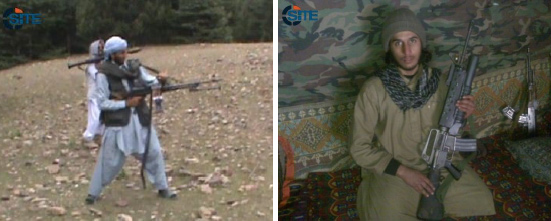
|
|
Left and right images: Abu Hamza al Omani. Images from the SITE Intelligence Group.
|
An Omani jihadist was among several foreign fighters who were killed in a recent US drone strike in the "Khorasan," according to a statement released on jihadist Internet forums.
The statement, which was unsigned, said that Abu Hamza al Omani, also known as Imran bin Abdullah bin Khamis al Balochi, was killed in a US airstrike on May 5, 2012 along with several other "brothers and supporters" who were not identified.
"The courageous knight dismounted on the night of Saturday, 5 May 2012, when the planes of the infidel enemy targeted a center in which there were several mujahideen. The brother fell as a martyr, accompanied by a number of his brothers and supporters...," said the statement, which was translated by the SITE Intelligence Group.
Although the location of the "center" was not disclosed, the statement claimed that Abu Hamza al Omani and the other fighters were killed in "the land of Khorasan," which includes Pakistan and Afghanistan.
On May 5, the US carried out a drone strike in the Shawal Valley in North Waziristan. The strike targeted a compound known to be used as a training center, killing 10 "militants" [see LWJ report, US drones kill 10 in North Waziristan]. Situated near the Afghan border, the Shawal Valley is a known operating area for al Qaeda, the Movement of the Taliban in Pakistan, and Taliban fighters under the command of Hafiz Gul Bahadar, the leader of the Taliban in North Waziristan.
Al Qaeda and the Khorasan
The term "Khorasan" refers to a region that encompasses large areas of Afghanistan, Pakistan, Uzbekistan, Tajikistan, and Iran. Jihadists consider the Khorasan to be the area where they will inflict the first defeat against their enemies in the Muslim version of Armageddon. The final battle is to take place in the Levant - Israel, Syria, and Lebanon.
Mentions of the Khorasan have begun to increase in al Qaeda's propaganda over the past several years. After al Qaeda's defeat in Iraq, the group began shifting its rhetoric from promoting Iraq as the central front in its jihad and has placed the focus on the Khorasan.
Al Qaeda typically is referring to Afghanistan and Pakistan's tribal areas when it mentions Khorasan. In February 2012, a senior al Qaeda operative said that al Qaeda is "still standing" despite repeated US drone strikes in the Khorasan; the US drone program in the region primarily kills al Qaeda leaders and fighters in Pakistan's tribal areas. Also in February 2012, al Qaeda released images of leaders and fighters who were killed in drone strikes in Pakistan's tribal areas and in airstrikes in Afghanistan.
Abu Hamza and jihad
According to Abu Hamza's martyrdom statement, he "grew up in a humble home in Barka province" (likely a reference to the coastal city of Barka in northern Oman) and "completed his secondary education and enrolled in the High Technical College." Abu Hamza then abandoned his degree and moved "to the land of migration and jihad," or Afghanistan, with others about one year ago.
The statement claimed that Abu Hamza traveled to the Khorasan with Abu Obedia al Omani, who was killed while fighting along the Afghan-Pakistan border on Jan. 8, 2012. Abu Hamza and others were wounded in the "bombing by the planes of the infidel enemy" that killed Abu Obedai.
Abu Hamza served as a trainer, according to the statement.
"He quickly mastered the art of fighting and he specialized in the cannon and would train his brothers on it," his martyrdom statement said. "His brothers knew him only as a person who was stationed in the front lines of combat, committed to his front," the statement continued, in all likelihood referring to Afghanistan. "[A]nd whenever he left one he would go to another, seeking combat or death."
Al Qaeda is known to embed small teams of trainers with the Taliban and other terrorist groups in Afghanistan, and in the east is known to fight on the battlefield in small units. [See LWJ reports, Al Qaeda's paramilitary 'Shadow Army' and 'Foreign trainers' active in southeastern Afghan province, for more information on al Qaeda's role in Afghanistan.]
The martyrdom statement indicated that a group of Omanis is still operating along the Afghan-Pakistani border. In addition to the statement that Abu Hamza traveled to the Khorasan with several other Omanis, one of the pictures showed "a group of Omani brothers while heading out for one of the operations."
Read more: http://www.longwarjournal.org/archives/2012/05/us_drones_kill_omani.php#ixzz1uwJk7rFE









 Washington Time
Washington Time Kabul Time
Kabul Time London Time
London Time








0 comments:
Post a Comment